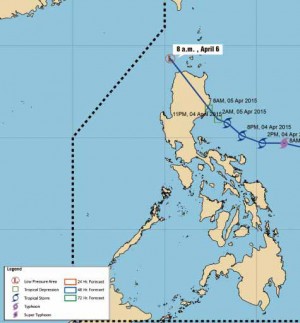‘Chedeng’ fizzles on glorious Easter Day

Fr. Joefran Talaban, parish priest of Nuestra Señora de la Salvacion Church in Barangay Bianoan, Casiguran, Aurora province, heaved a sigh of relief Sunday, echoing his parishioners’ sentiment on a glorious Easter in Aurora province.
“The Lord died on Good Friday, but he did not remain silent to our prayers,” Talaban said by phone.
“Chedeng” (international name: Maysak), billed as a supertyphoon last week, weakened into a tropical depression as it hit land early Sunday at the boundary of Aurora and Isabela provinces, briefly drenching wide areas along the eastern coast of Luzon but causing no casualties or major damage, according to the National Disaster Risk Reduction and Management Council (NDRRMC).
The Philippine Atmospheric, Geophysical and Astronomical Services Administration (Pagasa) said Chedeng struck Dinapigue, Isabela province, early yesterday with center winds of 55 kilometers per hour. It is expected to exit either Tuesday or Wednesday to the West Philippine Sea.
All public storm warnings were lifted yesterday afternoon.
Article continues after this advertisementREAD: ‘Chedeng’ dissipates to LPA, all storm signals lifted in PH
Article continues after this advertisement“As of now, most of our fears have melted away,” said chief state weather forecaster Esperanza Cayanan.
The storm killed nine people as it barreled through sparsely populated Micronesia in the Pacific last week with ferocious winds of 250 kph.
The NDRRMC earlier said more than 25,000 people were sent to higher ground and that thousands of tourists that had flocked to beach resorts for the Holy Week were told to pack their bags and depart ahead of a potential superhowler similar to one that left more than 6,300 dead in the Visayas in 2013.
READ: Thousands flee ‘Chedeng’
Casiguran residents were thankful because their rice and coconut farms were spared this time. In 2013, Typhoon “Labuyo” (international name: Utor) destroyed houses, forests, mangroves, farms and fishponds in Aurora.
“We were not hit by Chedeng. It was not strong as we expected. We experienced only drizzles. This must be because of our collective praying and because the mountains in San Ildefonso Peninsula served as protective wall,” Talaban said.
At San Luis Obispo Church in the Aurora capital town of Baler, Fr. Nilvon Villanueva drew hundreds of Catholics to his 4 a.m. Mass. The traditional “salubong” (meeting) of Christ and the Virgin Mary was held on a beach.
“The faithful were not afraid to attend the Mass amid a coming storm,” said Alfonso van Zijl, a Dutch who has been working with farmers, fishermen and indigenous people through the Church-based Bataris Foundation.
Power of faith
Fr. Israel Gabriel, parish priest of San Luis town, believed that an “oratio imperata” (obligatory prayer) recited in the nine parishes on the Aurora side of the Prelature of Infanta (Quezon province) worked to put the people out of harm’s way.
“The weather disturbance failed to challenge the power of our faith in God. We prayed together knowing we had no one to turn to but God,” Gabriel said.
The NDRRMC said 507 families (2,005 people) who were evacuated from Baler, Dipaculao, Casiguran and Dilasag towns returned to their homes before noon yesterday.
In Isabela, rice farmer Jun Nicolas said rainfall from Chedeng was “a blessing” for parched farmlands.
But Isabela Gov. Faustino Dy III said rain in Isabela was not enough to replenish Magat Dam. “There should have been more rain but we are thankful that (Chedeng) did not wreak havoc,” Dy said.
At least 172 families evacuated from Dinapigue, Divilacan and Maconacon towns had all returned home, he said.
In Nueva Ecija province, rice farmers said they were relieved that the storm spared their crops.
Only about 10 percent of the 160,000 hectares of rice planted in Nueva Ecija this cropping season had been harvested so far, said Serafin Santos, provincial agriculturist. Irrigation officials were dismayed there was no rain to fill up Pantabangan Dam.
In Virac, Catanduanes province, district engineer Romeo Doloiras reported no damage to roads and bridges.
Still, airline companies canceled 12 domestic flights yesterday from Ninoy Aquino International Airport.
Mayors still on alert
Interior Secretary Manuel “Mar” Roxas II ordered municipalities to remain on alert.
“We ask the mayors to ensure the safety of their residents and those on vacation. Let us continue monitoring and attending to their needs while keeping posted on weather updates,” Roxas said.
Social Welfare Secretary Corazon “Dinky” Soliman said her department’s disaster teams were assessing the extent of the disaster “so that we can provide appropriate services for the affected families.”
Undersecretary Alexander Pama said the NDRRMC had yet to receive reports of casualties from the tropical depression.
“We are still monitoring its effects. We are not yet in a hurry to downgrade our alert status to blue alert,” the council chief said in a press briefing. With reports from Anselmo Roque, Inquirer Central Luzon; Villamor Visaya Jr. and Gabriel Cardinoza, Inquirer Northern Luzon; Fernan Gianan, Inquirer Southern Luzon; and Julie Aurelio, Dona Z. Pazzibugan and Jeannette I. Andrade in Manila
